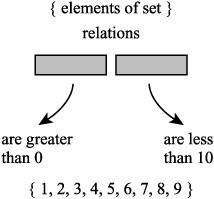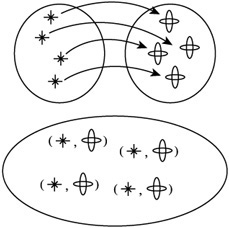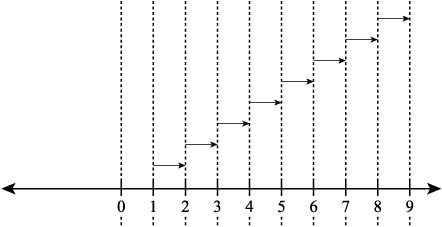More on Sets
In Chapter 3, you investigated some of the activities that involve sets. To extend the previously developed notions, consider that when you define a set, you can define it so that its elements bear relationships with each other. If you investigate a set that consists of numbers that are less than 10 and greater than zero, for example, then you can create a definition along the following lines:
{a | a = 10 ∧ a | a > 0}
This expression reads along the lines of “a such that a is less than 10 and a such that a is greater than 0.” While the numbers 0 and 10 are not part of the set, all the numbers in the set are defined by two common features: They must be greater than 0 and they must be less than 10. As Figure 4.2 illustrates, the features of the numbers are based on relations.
Figure 4.2. A set can be characterized by a set of numbers possessing common relations with numbers outside the set.

As shown in Figure 4.2, you can illustrate the numbers greater than 0 and less than 10 just by listing them within curly braces:
{1, 2, 3, 4, 5, 6, 7, 8, 9}
As the discussion in Chapter 3 emphasized, you can relate any set to any other set through such operations as union, intersection, or disjunction. In this respect, then, it becomes evident that you can view some sets as collections of pairs. As Figure 4.3 illustrates, the relations between elements in the two sets allow you to see domain-range relations in the bottom set.
Figure 4.3. Correspondence can pertain between elements in the same set or elements in different sets.

When you begin examining how sets of elements can be defined through relations, you can extend the discussion to include the notion of ordered pairs. A pair is a set of two items. These items can be elements you take from different sets. Likewise, when you can use one element in the pair to define the other element in the pair through a relationship that you can explicitly state, then the two elements exist as an ordered pair.
Consider a relationship in which the first element in the ordered pair is 1 less than the second element. You might state this formally using this expression: (a, b) | a = b – 1. Figure 4.4 illustrates the ordered pairs that follow from this relationship.
Figure 4.4. A relation establishes a way to discern ordered pairs.

Formally defining a relationship and then generating values is one way to create ordered pairs. Another approach is to begin with a collection of ordered pairs that you somehow discover, and then search for a way to formally describe how the paired numbers relate to each other. Dealing with the ordered pairs Figure 4.4 illustrates, for example, you can observe that as you go from 1 to 8, you can detect a pattern. The pattern is that if you begin with the first number and add 1, then you get the second number. As Figure 4.5 illustrates, you can proceed to mathematically express the relationship.
Figure 4.5. A set relation provides a standard way to generate ordered pairs of numbers.

As shown in Figure 4.6, when you are dealing with ordered pairs, a number line becomes an effective starting place for making mathematical translations of the relationships you observe.
Figure 4.6. Use a number line to explore a relation that allows you to define ordered pairs.

